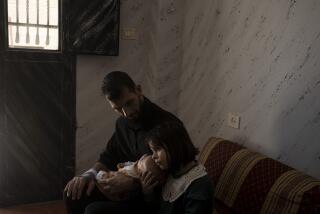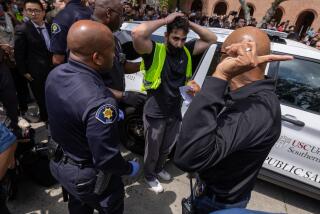3 Relief Workers Shot in Riot Aftermath
QALA-I-JANGY, Afghanistan — Crenelated ramparts circle the rim of the fortress like icing piped on pastry. On the ground below, a concrete stairway stands pink and incongruous amid the rubble, its steps descending into the earth, a pastel passage to the underworld.
For three health workers helping the International Committee of the Red Cross collect bodies here in northern Afghanistan on Thursday, that’s exactly what it turned out to be.
They thought it was safe. Two days earlier, the Northern Alliance had quelled an uprising by as many as 500 Taliban prisoners--many of them foreign fighters from countries such as Pakistan and Saudi Arabia. The three local men were sent down the stairway to retrieve bodies lying in a series of underground jail rooms.
They were greeted by a volley of gunfire. Two were injured and managed to escape; the third remained inside. After more gunshots were heard from below, the man was presumed dead.
Northern Alliance officials at the fortress said they believe a single Taliban fighter remained alive, hiding out in the underground rooms. And the determination of the soldier to hold out alone, they said, proves that the alliance has had no choice but to battle with him and his comrades to the death.
“They are terrorists,” Shahzada Khan, the director of the fortress and its underground prison, said Thursday. “They are like terrorists all around the world. They would not listen to us. They didn’t want to negotiate.”
Accounts of events during the three-day siege remain fragmentary and sometimes contradictory, but its spark was apparently the killing of CIA officer Johnny “Mike” Spann by a grenade-wielding Taliban prisoner.
After Spann was killed, British special forces called in U.S. airstrikes, which helped put down the rebellion. In its wake, calls are growing for an inquiry into the uprising, including the role of the United States and Britain.
On her way to London on Thursday, the U.N. high commissioner for human rights, Mary Robinson, echoed Amnesty International’s call for an investigation. Donald Anderson, Britain’s Labor Party chairman of the House of Commons Foreign Affairs Committee, said the United Nations should conduct the investigation.
“I have no doubt many of the Arab prisoners and other outsiders would have chosen martyrdom, but the fact that there were such numbers . . . these are all matters that need to be investigated,” Anderson said in a telephone interview.
Inside the fortress Thursday, the debris of a fierce battle was evident. Pools of blood stained the ground next to charred machine-gun tripods. Spent cartridges, artillery rounds and mortars littered the ground. Piles of rubble from a bombed ammunition depot smoked threateningly.
A rich smell of pine resin emanated from shattered trees along the fortress’ central walkway, briefly overpowering the acrid smell of burning gunpowder and the stench of rotting horse carcasses.
Northern Alliance fighters concentrated on flushing out or killing the underground Taliban holdout. They removed the rear casings from a dozen rockets, attached short straw fuses and fired them one by one down the stairway and into other openings to the subterranean rooms. Between rockets, they fired AK-47 assault rifles into the smoke and darkness underground.
Northern Alliance officials say many of the approximately 500 prisoners who rebelled were foreign Taliban, some of whom are believed to have ties to Osama bin Laden’s Al Qaeda terrorism network.
They were among the last defenders of the city of Kunduz, which fell to the Northern Alliance on Sunday. The fighters bypassed the main Kunduz commander and drove west to surrender to Northern Alliance Gen. Abdul Rashid Dostum, who promised to treat them humanely.
According to prison officials, the first trouble with the inmates began Saturday night when a prisoner who had squirreled away a grenade blew himself up, killing two top Northern Alliance commanders as well.
The following morning, the Northern Alliance brought some of the prisoners up from the underground cells to search them for explosives and weapons and question them about their relationship to Bin Laden.
According to a Northern Alliance soldier who witnessed the event, a CIA agent--Spann--was present. At 10:30 a.m., a Taliban fighter threw himself at Spann, detonating a grenade and killing the American. A second agent then opened fire, killing as many as 20 of the prisoners, he said.
In the resulting confusion, he said, some of the prisoners managed to get into the ammunition depot and arm themselves, and the uprising was on.
Khan, the fortress director, said a full-scale battle was unavoidable.
“We didn’t want to fight against them,” he said. “But they chose to fight with us, and we had to defend ourselves.”
Asked why Taliban soldiers who had peacefully surrendered would suddenly turn on their captors, Khan said, “Perhaps that was their plan all along.”
Before the shooting incident halted their operations Thursday, the Red Cross managed to collect 150 bodies that had littered the grounds.
Because the prison population was estimated at 450 to 500, officials of the relief agency say they expect to find many bodies in the underground rooms. Prison and Red Cross officials said it is unclear when it may be safe to enter them.
Some news reports have said that some of the battlefield dead had their hands tied behind their backs, suggesting that they weren’t fighting when they died and might have been summarily executed.
Simon Brooks, a spokesman for the Red Cross in the nearby city of Mazar-i-Sharif, said he couldn’t confirm such reports.
“None of the bodies we have collected had their hands tied,” he said. “On the other hand, the condition of the bodies we have seen has been horrific. It’s hard to identify facial features and very difficult to determine what kind of treatment they have received before death.”
Any inquiry into events at Qala-i-Jangy will have to include discussion of the role of U.S. and British personnel, who are a visible presence at the fortress and in Mazar-i-Sharif.
British special forces helped call in three U.S. bomb strikes--two struck the buildings with Taliban holdouts, and the third went astray and hit the mud-brick wall of the compound.
The U.S. influence is palpable in Qala-i-Jangy. White cardboard ammo boxes reading “Made in USA” litter the ground. So do green ammunition packages and bright yellow U.S. humanitarian food aid pouches.
Many of the Northern Alliance soldiers wear brand-new U.S. Army jackets.
A group of British SAS forces and one American who appeared to be a military advisor were seen at the prison complex Thursday, but they declined to answer questions from reporters.
Northern Alliance soldiers at the scene clearly relished the contact with the United States and the role they are playing in efforts to find and punish those responsible for the Sept. 11 attacks.
As the rockets were being fired into the underground bunker, a Northern Alliance fighter who gave his name as Abdul Aziz Mujahed tugged at a reporter’s sleeve.
He rolled up his left pant leg over his knee to reveal a 6-inch-long scar. “Bin Laden,” he said in explanation. He tugged at his waistband and uncovered a scar on his right hip. “Bin Laden,” he said again. He pulled at his shirt collar to reveal yet another puckered scar and pointed to his back to indicate still one more. “Bin Laden,” he said, grinning.
His bare ankles were tucked into gray sneakers. He lifted a foot and pointed to a dark smear of blood on the instep.
“Taliban,” he said, and gave a thumbs up.
Times staff writer Marjorie Miller in London contributed to this report.
More to Read
Sign up for Essential California
The most important California stories and recommendations in your inbox every morning.
You may occasionally receive promotional content from the Los Angeles Times.










